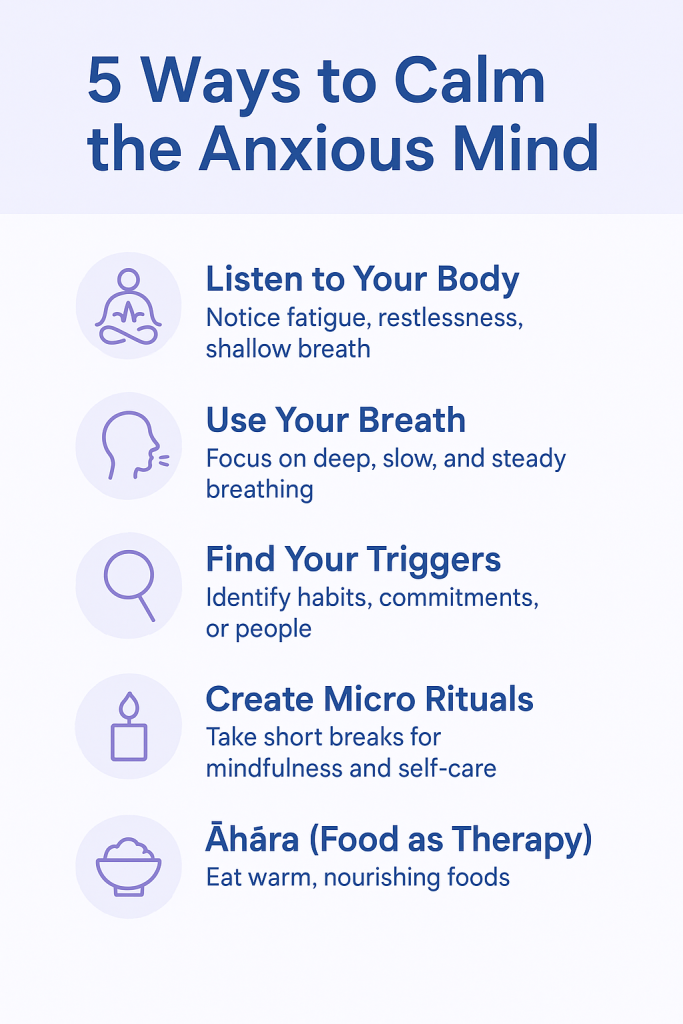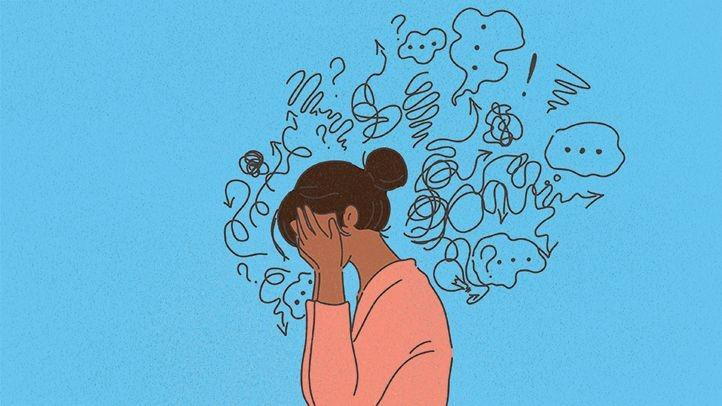Anxiety doesn’t always arrive as panic.
Sometimes, it begins as restlessness — a busy mind, a body that can’t quite relax.
It’s the quiet hum beneath the surface — a sense that you’re on, even when you want to be off.
This is often how Generalized Anxiety Disorder (GAD) begins — not with crisis, but with a collection of subtle, persistent signals from the body and mind.
What Is GAD?
Generalized Anxiety Disorder (GAD) is a mental health condition marked by excessive and persistent worry, restlessness, and an inability to relax. Over time, these patterns begin to disrupt sleep, digestion, and emotional balance.
Research shows that GAD involves hyperactivation of the amygdala and dysregulation of the prefrontal cortex and vagus nerve, keeping the body in a chronic state of readiness (Etkin & Wager, 2015; Porges, 2011).
In Yogic Terms
From the yogic and Ayurvedic perspective, anxiety arises when Prāṇa Vāyu (upward-moving energy) overpowers Apāna Vāyu (grounding energy).
This imbalance reflects an aggravation of Vāta doṣa — excess movement and dryness in the mind and body, leading to instability, fatigue, and fear.
When Vāta increases, prāṇa (life force) becomes scattered. The mind loses its anchor. Listening early makes all the difference.
Early Signs: The Body’s First Language
Before anxiety becomes overwhelming, it whispers:
- Restless body or fidgeting
- Racing or looping thoughts
- Muscle tightness (shoulders, neck, jaw)
- Uneasy stomach or poor digestion
- Light sleep, fatigue, or frequent sighing
- Feeling ungrounded or “spaced out”
How to Help Yourself

1. Listen to Your Body Before It Shouts
Don’t wait for your body to send a loud message through burnout, panic, or exhaustion.
Notice the whispers — fatigue, distraction, restlessness, shortness of breath.
Lesson: Don’t wait for the breakdown. Hear the whispers and respond with care.
Create your personal grounding toolkit:
- Gentle asanas: Child’s Pose (Balāsana), Forward Folds, Legs-up-the-Wall (Viparita Karani)
- Therapeutic movements: Slow fascia releases, fluid spinal undulations
- Vagus tone techniques: Humming, chanting Om, gentle neck stretches, extended exhalations
- Prāṇāyāma: Alternate Nostril Breathing (Nāḍī Śodhana), Bhrāmarī (humming bee breath)
- Yoga Nidra: Deep rest and nervous system reset
- Self-soothing: Warm oil massage (Abhyanga), restorative yoga, walking in nature
2. Āhāra: Nourishment for a Calm Mind
In Ayurveda, the mind is fed not only by thoughts but also by food.
An anxious mind needs warmth, stability, and nourishment.
Choose foods that pacify Vāta and build Ojas (vital energy):
- Freshly cooked, warm, moist, and lightly spiced meals
- Root vegetables, ghee, and warm milk with nutmeg or ashwagandha
- Whole grains such as oats, rice, and quinoa
- Sweet, grounding fruits — bananas, dates, cooked apples
- Sāttvic foods — light, pure, and energizing: fresh fruits, vegetables, whole grains, legumes, nuts, and herbal teas
Avoid or reduce:
- Caffeine, alcohol, and nicotine (they aggravate Vāta and anxiety)
- Highly processed, dry, or cold foods
- Irregular meal times or skipping meals
- Overstimulation — too much media, noise, or multitasking
“As the food, so the mind.” — Charaka Saṃhitā, Sūtrasthāna 27.349
The sāttvic diet supports clarity, stability, and compassion — the natural state of a peaceful mind.
3. Find Your Triggers
Anxiety often hides behind habits that seem harmless — saying yes too often, people-pleasing, or endless scrolling.
Reflect:
What small habits, commitments, or relationships quietly drain my energy?
Identifying these patterns redirects your prāṇa toward nourishment instead of depletion.
4. Create Micro Daily Self-Care Rituals
You don’t need to retreat to the mountains or meditate for an hour.
Start small — moments of presence between calls, commutes, or while brushing your teeth.
Consistent, mindful rituals rebuild the nervous system’s sense of safety and trust.
Compassionate Call to Action
If you recognize yourself in these words — the restless nights, the racing thoughts, the quiet fatigue — take this as your sign, not of weakness, but of awareness.
Healing begins when you choose to pause.
Start small: one slow breath, one nourishing meal, one gentle practice.
Let’s learn to listen before the body shouts.
Your peace is not somewhere else — it’s waiting for your attention.
References
- Etkin, A., & Wager, T. D. (2015). Functional neuroimaging of anxiety: A meta-analysis of emotional processing in PTSD, social anxiety disorder, and specific phobia. American Journal of Psychiatry, 162(2), 147–157.
- Porges, S. W. (2011). The Polyvagal Theory: Neurophysiological Foundations of Emotions, Attachment, Communication, and Self-Regulation. W.W. Norton.
- Zaccaro, A. et al. (2018). How breath-control can change your life: A systematic review on psycho-physiological correlates of slow breathing. Frontiers in Human Neuroscience, 12, 353.
- Charaka Saṃhitā, Sūtrasthāna 27.349 – “Āhāra is the source of strength, complexion, and vitality.”


